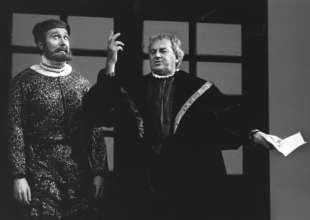Speight’s Wagner Memories: 89 MEISTERSINGER

Roger Roloff (Hans Sachs) and Julian Patrick (Beckmesser) in Wagner’s Die Meistersinger von Nürnberg, 1989 © Matthew McVay
I was delighted in this production to bring back to the United States after a long absence the remarkable Texas soprano, Helen Donath. For the next ten or twelve years, she had a very active American career, including many appearances at the Metropolitan Opera. Donath’s Eva was superb. It was thrilling, too, to present Ben Heppner in his first Walther, his first Wagner role in the United States. He was remarkable, as was Julian Patrick as Beckmesser. Hermann Michael conducted his first Meistersinger with a real sense of warmth and love.
One comic touch was the naming in the program of a singer for the role of the famously sick Niklaus Vogel. In the roll call of Masters in Act I, the apprentice of Vogel calls out that his master is not present because he is ill. We included Vogel in the dramatis personae, identified a singer for his part, and put the picture of this singer and his biography in the program as well. In doing so, we committed a slight anachronism: we named him Ludwig Schnorr von Carolsfeld, the first Tristan. He actually had died in the summer of 1865, three years before the Meistersinger premier, but it was a good laugh for the Wagnerians who read their programs.
The most exciting musical recollection involved following Wagner’s instructions. Rochaix planned for chorus entrances that would carry out Wagner’s antiphonal demands during the riot. When he told George Fiore, our chorusmaster, Fiore said that all the chorus always sings all the music in unison in that section. I called the various American houses that perform Meistersinger and found that this was the case. Inquiries at Bayreuth and Covent Garden revealed the same. Everyone said that it’s too hard to do anything but sing it in unison. George, however, said that his choristers could learn it, and Rochaix said it had to be. It worked perfectly and was not hard for anyone. I don’t know whether the audience consciously was aware of what we did, but it certainly sounded very different and more believable to me.
Another small musical point: Rochaix wanted Beckmesser to have his own lutanist onstage so that his serenade could be accompanied there and not in the pit. It was a lovely touch.
Several staging moments stand out: Beckmesser’s crossing the stage, far in the rear, looking on as the five principals sang the quintet. Sachs’s workroom in this production was revealed on stage left with a lot of the stage open. It was an intimate room. For the quintet, all the principals were standing just outside the workroom. Rochaix felt that at this crucial moment in the drama Beckmesser should not be forgotten. In the concluding Festwiese, I asked for something that I had seen in the Meistersinger of Kurt Horres in Belgium several years before. Though the Théâtre de la Monnaie is much, much more intimate than was the Seattle Center Opera House at the time, we were able to do what was done there. During the celebratory procession, the bakers brought rolls with them. As they entered the auditorium and walked up on the stage, they threw rolls to the audience in the house. Although we had to construct platforms so that they could walk up on the stage, it was worth it. Also in Seattle we had to be careful that the rolls were soft. The distance was greater, and the choristers liked the idea of throwing overhand as though the rolls were baseballs. We all visualized them hitting an elderly woman on the head. It didn’t happen. Instead, it was the equivalent of the 10:30 number on Broadway. After being in the opera house for almost five hours, suddenly something completely unexpected happened, and the audience became a part of the Festwiese. The proscenium disappeared, and everyone laughed at Beckmesser and rejoiced in Walther’s victory. Nuremberg indeed came to Seattle.